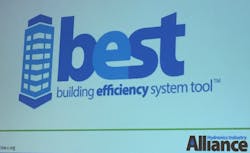Comparison Tool Delivers 'Best' HVAC Design in a Snap
By MIKE EBY, Senior Director of Content, Informa Buildings, Infrastructure Intelligence
In the Tuesday morning session “The BEST Way to Compare HVAC Systems in the Early Project Design Phase” at AHR Expo 2019, speakers Mark Chaffee, VP of government relations and sustainability, Radiant Professionals Alliance (RPA) - Taco, and Greg Cunniff, principal, Williams Comfort Products, showed attendees the speed at which they could easily analyze real-world HVAC options to pinpoint the system that best meets budgetary and performance requirements.
The free, interactive Building Efficiency System Tool™ (BEST) allows design professionals to accurately compare different styles of HVAC systems, which are all tested to different standards with various efficiency ratings (EER, IEER, SEER, COP, HSPF), as they are applied in an actual building. The software tool was created to better inform prospective builders, consulting engineers and design-build professionals about their selection options for HVAC systems during the early design process.
BEST uses the Building Energy Efficiency Ratio (BEER), which takes certified AHRI data, manufacturer’s published performance data at multiple performance points, as-applied correction factors, performance curves for components, pipe and duct required in a typical system, and combines them to bridge the gap between certified equipment efficiencies and real-world building system efficiencies.
Although Cunniff noted there were 30 pre-configured systems built into the tool, he pointed out that you could easily build your own systems and save them for future comparative analysis. He then ran through a quick demo of the tool and showed how easy it was to use.
He simply entered the square footage of the building, the number of stories, and the nearest city for local weather data, and then chose four types of HVAC systems to compare. With a simple click of the mouse, BEST produced several graphs showing estimated installation cost, replacement cost, maintenance cost, monthly energy cost, electrical and fossil fuel consumption costs, total life cycle cost, cumulative life cycle cost by year, and system payback time.
When asked where the cost components were obtained, Cunniff offered this explanation.
In 2018, the organization got 50 contractors to give them construction costs per square foot to install the various types of systems in the tool. Maintenance costs were obtained from some ASHRAE research data and some input from the contractor community. These numbers were blended to come up with an average. Utility costs were obtained from the DOE (2018, state by state). But the beauty of the tool is if you don’t like these numbers it allows you to easily modify them and plug in your own real-world data.
So download the BEST for free and give it a try.
